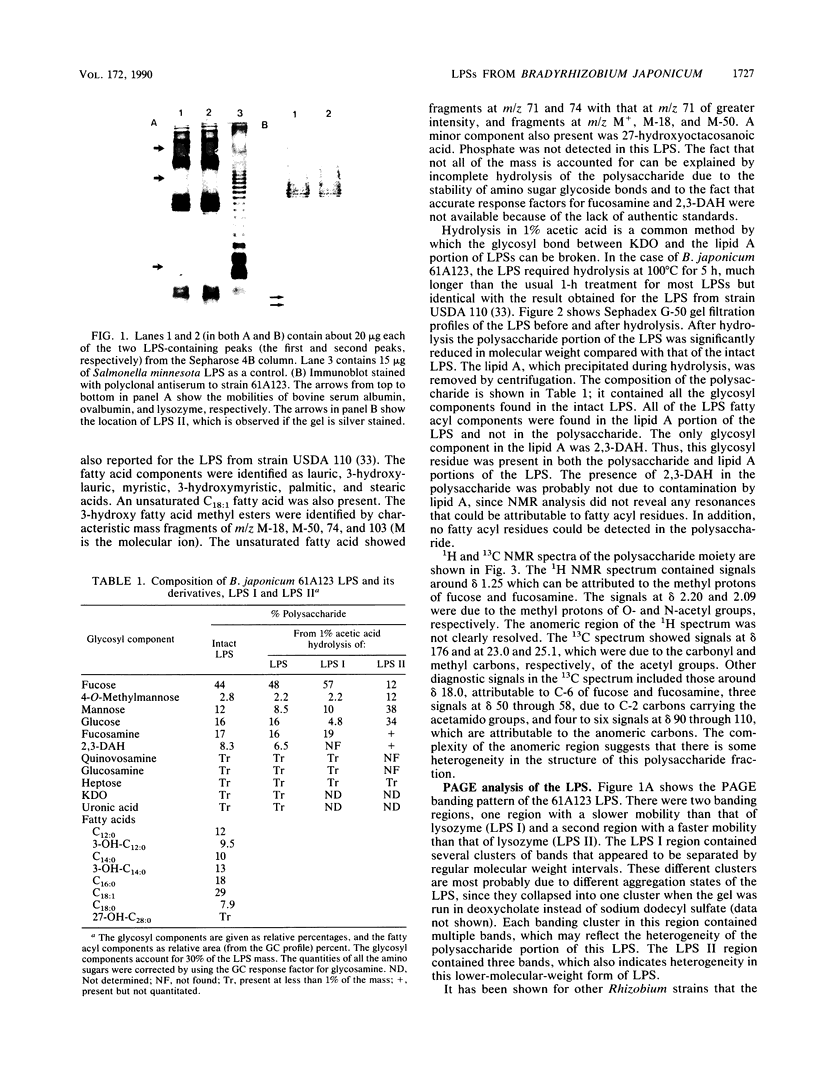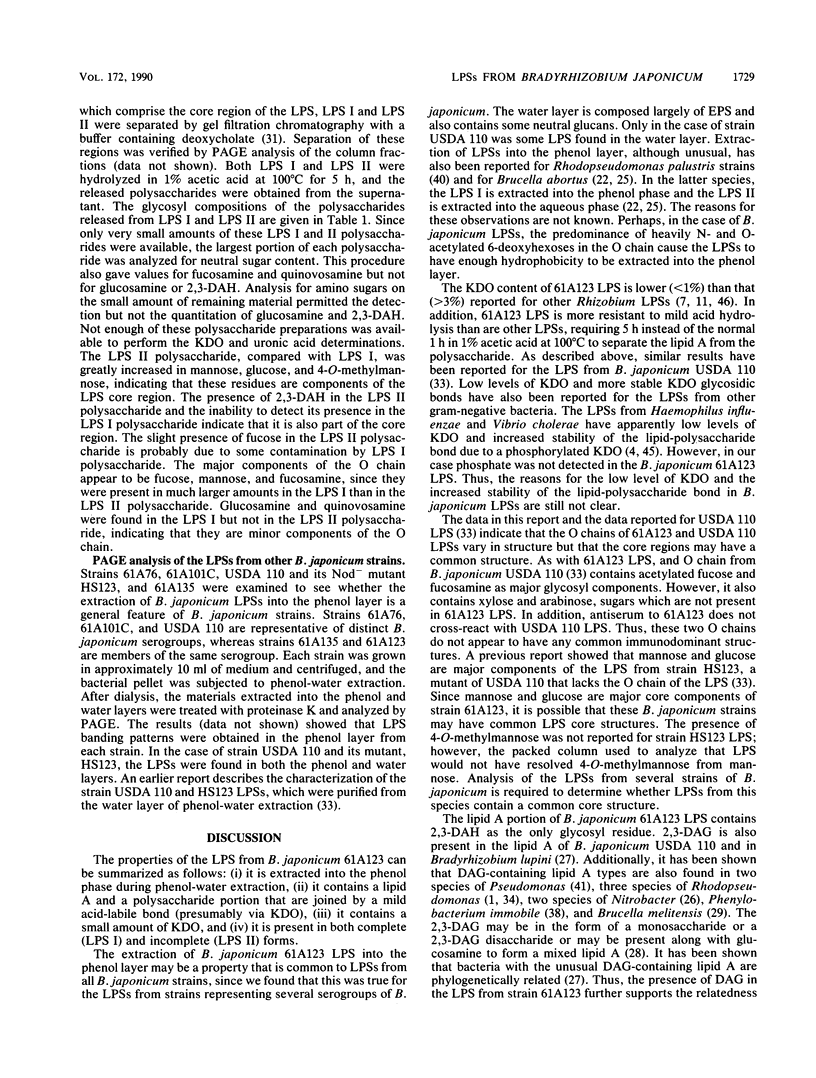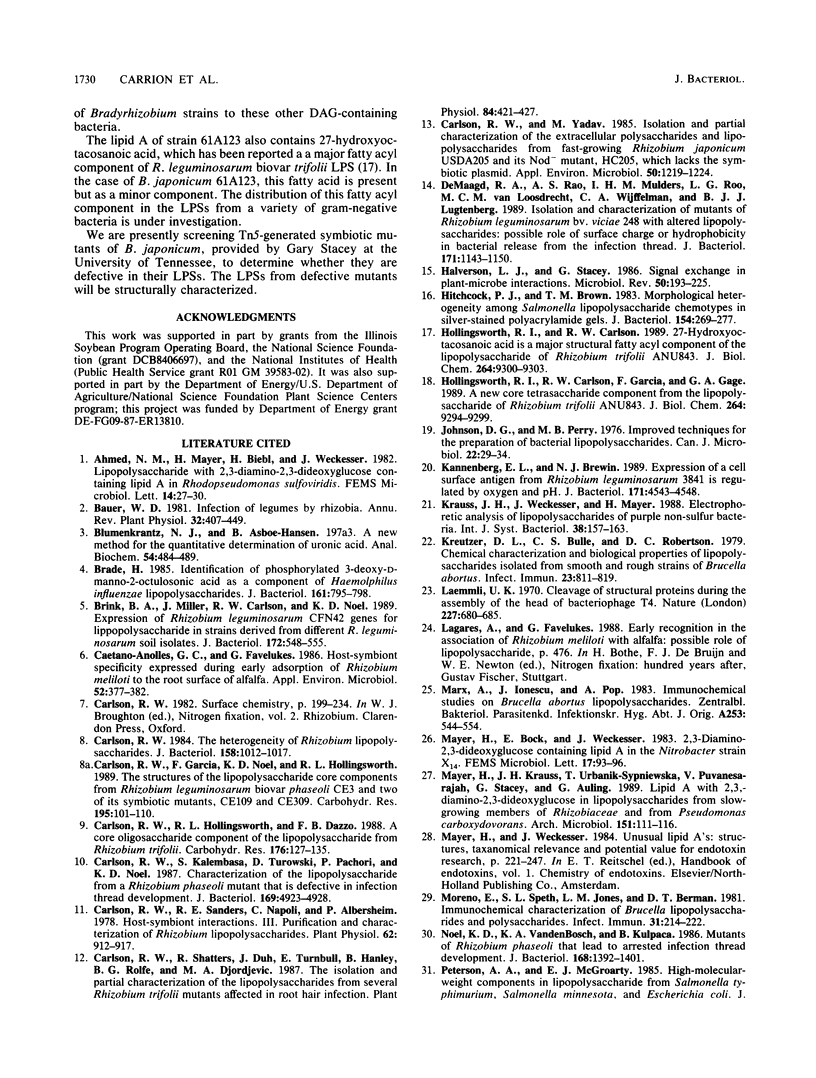Abstract
The lipopolysaccharide (LPS) of Bradyrhizobium japonicum 61A123 was isolated and partially characterized. Phenol-water extraction of strain 61A123 yielded LPS exclusively in the phenol phase. The water phase contained low-molecular-weight glucans and extracellular or capsular polysaccharides. The LPSs from B. japonicum 61A76, 61A135, and 61A101C were also extracted exclusively into the phenol phase. The LPSs from strain USDA 110 and its Nod- mutant HS123 were found in both the phenol and water phases. The LPS from strain 61A123 was further characterized by polyacrylamide gel electrophoresis, composition analysis, and 1H and 13C nuclear magnetic resonance spectroscopy. Analysis of the LPS by polyacrylamide gel electrophoresis showed that it was present in both high- and low-molecular-weight forms (LPS I and LPS II, respectively). Composition analysis was also performed on the isolated lipid A and polysaccharide portions of the LPS, which were purified by mild acid hydrolysis and gel filtration chromatography. The major components of the polysaccharide portion were fucose, fucosamine, glucose, and mannose. The intact LPS had small amounts of 2-keto-3-deoxyoctulosonic acid. Other minor components were quinovosamine, glucosamine, 4-O-methylmannose, heptose, and 2,3-diamino-2,3-dideoxyhexose. The lipid A portion of the LPS contained 2,3-diamino-2,3-dideoxyhexose as the only sugar component. The major fatty acids were beta-hydroxymyristic, lauric, and oleic acids. A long-chain fatty acid, 27-hydroxyoctacosanoic acid, was also present in this lipid A. Separation and analysis of LPS I and LPS II indicated that glucose, mannose, 4-O-methylmannose, and small amounts of 2,2-diamino-2,3-dideozyhexose and heptose were components of the core region of the LPS, whereas fucose, fucosmine, mannose, and small amounts of quinovosamine and glucosamine were components of the LPS O-chain region.
Full text
PDF






Images in this article
Selected References
These references are in PubMed. This may not be the complete list of references from this article.
- Brade H. Occurrence of 2-keto-deoxyoctonic acid 5-phosphate in lipopolysaccharides of Vibrio cholerae Ogawa and Inaba. J Bacteriol. 1985 Feb;161(2):795–798. doi: 10.1128/jb.161.2.795-798.1985. [DOI] [PMC free article] [PubMed] [Google Scholar]
- Brink B. A., Miller J., Carlson R. W., Noel K. D. Expression of Rhizobium leguminosarum CFN42 genes for lipopolysaccharide in strains derived from different R. leguminosarum soil isolates. J Bacteriol. 1990 Feb;172(2):548–555. doi: 10.1128/jb.172.2.548-555.1990. [DOI] [PMC free article] [PubMed] [Google Scholar]
- Caetano Anollés G., Favelukes G. Host-Symbiont Specificity Expressed during Early Adsorption of Rhizobium meliloti to the Root Surface of Alfalfa. Appl Environ Microbiol. 1986 Aug;52(2):377–382. doi: 10.1128/aem.52.2.377-382.1986. [DOI] [PMC free article] [PubMed] [Google Scholar]
- Carlson R. W., Garci F., Noel D., Hollingsworth R. The structures of the lipopolysaccharide core components from Rhizobium leguminosarum biovar phaseoli CE3 and two of its symbiotic mutants, CE109 and CE309. Carbohydr Res. 1989 Dec 21;195(1):101–110. doi: 10.1016/0008-6215(89)85092-x. [DOI] [PubMed] [Google Scholar]
- Carlson R. W. Heterogeneity of Rhizobium lipopolysaccharides. J Bacteriol. 1984 Jun;158(3):1012–1017. doi: 10.1128/jb.158.3.1012-1017.1984. [DOI] [PMC free article] [PubMed] [Google Scholar]
- Carlson R. W., Hollingsworth R. L., Dazzo F. B. A core oligosaccharide component from the lipopolysaccharide of Rhizobium trifolii ANU843. Carbohydr Res. 1988 May 1;176(1):127–135. doi: 10.1016/0008-6215(88)84064-3. [DOI] [PubMed] [Google Scholar]
- Carlson R. W., Kalembasa S., Turowski D., Pachori P., Noel K. D. Characterization of the lipopolysaccharide from a Rhizobium phaseoli mutant that is defective in infection thread development. J Bacteriol. 1987 Nov;169(11):4923–4928. doi: 10.1128/jb.169.11.4923-4928.1987. [DOI] [PMC free article] [PubMed] [Google Scholar]
- Carlson R. W., Sanders R. E., Napoli C., Albersheim P. Host-Symbiont Interactions: III. Purification and Partial Characterization of Rhizobium Lipopolysaccharides. Plant Physiol. 1978 Dec;62(6):912–917. doi: 10.1104/pp.62.6.912. [DOI] [PMC free article] [PubMed] [Google Scholar]
- Carlson R. W., Shatters R., Duh J. L., Turnbull E., Hanley B., Rolfe B. G., Djordjevic M. A. The Isolation and Partial Characterization of the Lipopolysaccharides from Several Rhizobium trifolii Mutants Affected in Root Hair Infection. Plant Physiol. 1987 Jun;84(2):421–427. doi: 10.1104/pp.84.2.421. [DOI] [PMC free article] [PubMed] [Google Scholar]
- Carlson R. W., Yadav M. Isolation and partial characterization of the extracellular polysaccharides and lipopolysaccharides from fast-growing Rhizobium japonicum USDA 205 and its Nod- mutant, HC205, which lacks the symbiotic plasmid. Appl Environ Microbiol. 1985 Nov;50(5):1219–1224. doi: 10.1128/aem.50.5.1219-1224.1985. [DOI] [PMC free article] [PubMed] [Google Scholar]
- Halverson L. J., Stacey G. Signal exchange in plant-microbe interactions. Microbiol Rev. 1986 Jun;50(2):193–225. doi: 10.1128/mr.50.2.193-225.1986. [DOI] [PMC free article] [PubMed] [Google Scholar]
- Hitchcock P. J., Brown T. M. Morphological heterogeneity among Salmonella lipopolysaccharide chemotypes in silver-stained polyacrylamide gels. J Bacteriol. 1983 Apr;154(1):269–277. doi: 10.1128/jb.154.1.269-277.1983. [DOI] [PMC free article] [PubMed] [Google Scholar]
- Hollingsworth R. I., Carlson R. W. 27-Hydroxyoctacosanoic acid is a major structural fatty acyl component of the lipopolysaccharide of Rhizobium trifolii ANU 843. J Biol Chem. 1989 Jun 5;264(16):9300–9303. [PubMed] [Google Scholar]
- Hollingsworth R. I., Carlson R. W., Garcia F., Gage D. A. A new core tetrasaccharide component from the lipopolysaccharide of Rhizobium trifolii ANU 843. J Biol Chem. 1989 Jun 5;264(16):9294–9299. [PubMed] [Google Scholar]
- Johnson K. G., Perry M. B. Improved techniques for the preparation of bacterial lipopolysaccharides. Can J Microbiol. 1976 Jan;22(1):29–34. doi: 10.1139/m76-004. [DOI] [PubMed] [Google Scholar]
- Kannenberg E. L., Brewin N. J. Expression of a cell surface antigen from Rhizobium leguminosarum 3841 is regulated by oxygen and pH. J Bacteriol. 1989 Sep;171(9):4543–4548. doi: 10.1128/jb.171.9.4543-4548.1989. [DOI] [PMC free article] [PubMed] [Google Scholar]
- Kreutzer D. L., Buller C. S., Robertson D. C. Chemical characterization and biological properties of lipopolysaccharides isolated from smooth and rough strains of Brucella abortus. Infect Immun. 1979 Mar;23(3):811–818. doi: 10.1128/iai.23.3.811-818.1979. [DOI] [PMC free article] [PubMed] [Google Scholar]
- Laemmli U. K. Cleavage of structural proteins during the assembly of the head of bacteriophage T4. Nature. 1970 Aug 15;227(5259):680–685. doi: 10.1038/227680a0. [DOI] [PubMed] [Google Scholar]
- Marx A., Ionescu J., Pop A. Immunochemical studies on Brucella abortus lipopolysaccharides. Zentralbl Bakteriol Mikrobiol Hyg A. 1983 Feb;253(4):544–553. [PubMed] [Google Scholar]
- Mayer H., Krauss J. H., Urbanik-Sypniewska T., Puvanesarajah V., Stacey G., Auling G. Lipid A with 2,3-diamino-2,3-dideoxy-glucose in lipopolysaccharides from slow-growing members of Rhizobiaceae and from "Pseudomonas carboxydovorans". Arch Microbiol. 1989;151(2):111–116. doi: 10.1007/BF00414423. [DOI] [PubMed] [Google Scholar]
- Moreno E., Speth S. L., Jones L. M., Berman D. T. Immunochemical characterization of Brucella lipopolysaccharides and polysaccharides. Infect Immun. 1981 Jan;31(1):214–222. doi: 10.1128/iai.31.1.214-222.1981. [DOI] [PMC free article] [PubMed] [Google Scholar]
- Noel K. D., Vandenbosch K. A., Kulpaca B. Mutations in Rhizobium phaseoli that lead to arrested development of infection threads. J Bacteriol. 1986 Dec;168(3):1392–1401. doi: 10.1128/jb.168.3.1392-1401.1986. [DOI] [PMC free article] [PubMed] [Google Scholar]
- Puvanesarajah V., Schell F. M., Gerhold D., Stacey G. Cell surface polysaccharides from Bradyrhizobium japonicum and a nonnodulating mutant. J Bacteriol. 1987 Jan;169(1):137–141. doi: 10.1128/jb.169.1.137-141.1987. [DOI] [PMC free article] [PubMed] [Google Scholar]
- Roppel J., Mayer H. Identification of a 2, 3-diamino-2, 3-dideoxyhexose in the lipid A component of lipopolysaccharides of Rhodopseudomonas viridis and Rhodopseudomonas palustris. Carbohydr Res. 1975 Mar;40(1):31–40. doi: 10.1016/s0008-6215(00)82666-x. [DOI] [PubMed] [Google Scholar]
- VandenBosch K. A., Brewin N. J., Kannenberg E. L. Developmental regulation of a Rhizobium cell surface antigen during growth of pea root nodules. J Bacteriol. 1989 Sep;171(9):4537–4542. doi: 10.1128/jb.171.9.4537-4542.1989. [DOI] [PMC free article] [PubMed] [Google Scholar]
- WEISSBACH A., HURWITZ J. The formation of 2-keto-3-deoxyheptonic acid in extracts of Escherichia coli B. I. Identification. J Biol Chem. 1959 Apr;234(4):705–709. [PubMed] [Google Scholar]
- Weisshaar R., Lingens F. The lipopolysaccharide of a chloridazon-degrading bacterium. Eur J Biochem. 1983 Dec 1;137(1-2):155–161. doi: 10.1111/j.1432-1033.1983.tb07809.x. [DOI] [PubMed] [Google Scholar]
- Whittenbury R., McLee A. G. Rhodopseudomonas palustris and Rh. viridis--photosynthetic budding bacteria. Arch Mikrobiol. 1967;59(1):324–334. doi: 10.1007/BF00406346. [DOI] [PubMed] [Google Scholar]
- Wilkinson S. G., Taylor D. P. Occurrence of 2,3-diamino-2,3-dideoxy-d-glucose in lipid A from lipopolysaccharide of pseudomonas diminuta. J Gen Microbiol. 1978 Dec;109(2):367–370. doi: 10.1099/00221287-109-2-367. [DOI] [PubMed] [Google Scholar]
- Wood E. A., Butcher G. W., Brewin N. J., Kannenberg E. L. Genetic derepression of a developmentally regulated lipopolysaccharide antigen from Rhizobium leguminosarum 3841. J Bacteriol. 1989 Sep;171(9):4549–4555. doi: 10.1128/jb.171.9.4549-4555.1989. [DOI] [PMC free article] [PubMed] [Google Scholar]
- Zamze S. E., Ferguson M. A., Moxon E. R., Dwek R. A., Rademacher T. W. Identification of phosphorylated 3-deoxy-manno-octulosonic acid as a component of Haemophilus influenzae lipopolysaccharide. Biochem J. 1987 Jul 15;245(2):583–587. doi: 10.1042/bj2450583. [DOI] [PMC free article] [PubMed] [Google Scholar]
- de Maagd R. A., Rao A. S., Mulders I. H., Goosen-de Roo L., van Loosdrecht M. C., Wijffelman C. A., Lugtenberg B. J. Isolation and characterization of mutants of Rhizobium leguminosarum bv. viciae 248 with altered lipopolysaccharides: possible role of surface charge or hydrophobicity in bacterial release from the infection thread. J Bacteriol. 1989 Feb;171(2):1143–1150. doi: 10.1128/jb.171.2.1143-1150.1989. [DOI] [PMC free article] [PubMed] [Google Scholar]



